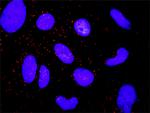Search Thermo Fisher Scientific
FIGURE: 1 / 1
CTNNA1 Antibody (H00001495-M03) in PLA

Product Details
H00001495-M03
Species Reactivity
Host/Isotype
Class
Type
Clone
Immunogen
Conjugate
Form
Concentration
Purification
Storage buffer
Contains
Storage conditions
Shipping conditions
Product Specific Information
Immunogen sequence: VQLKVVEDGI LKLRNAGNEQ DLGIQYKALK PEVDKLNIMA AKRQQELKDV GHRDQMAAAR GILQKNVPIL YTASQACLQH PDVAAYKANR DLIYKQLQQ
Target Information
Associates with the cytoplasmic domain of a variety of cadherins. The association of catenins to cadherins produces a complex which is linked to the actin filament network, and which seems to be of primary importance for cadherins cell-adhesion properties. Can associate with both E- and N-cadherins. Originally believed to be a stable component of E-cadherin/catenin adhesion complexes and to mediate the linkage of cadherins to the actin cytoskeleton at adherens junctions. In contrast, cortical actin was found to be much more dynamic than E-cadherin/catenin complexes and CTNNA1 was shown not to bind to F-actin when assembled in the complex suggesting a different linkage between actin and adherence junctions components. The homodimeric form may regulate actin filament assembly and inhibit actin branching by competing with the Arp2/3 complex for binding to actin filaments. May play a crucial role in cell differentiation.
For Research Use Only. Not for use in diagnostic procedures. Not for resale without express authorization.
References (0)
Bioinformatics
Protein Aliases: Alpha E-catenin; alpha-E-catenin; Cadherin-associated protein; catenin (cadherin-associated protein), alpha 1, 102kDa; Catenin alpha-1; Renal carcinoma antigen NY-REN-13
Gene Aliases: CAP102; CTNNA1; MDPT2
UniProt ID: (Human) P35221
Entrez Gene ID: (Human) 1495

Performance Guarantee
If an Invitrogen™ antibody doesn't perform as described on our website or datasheet,we'll replace the product at no cost to you, or provide you with a credit for a future purchase.*
Learn more
We're here to help
Get expert recommendations for common problems or connect directly with an on staff expert for technical assistance related to applications, equipment and general product use.
Contact tech support
